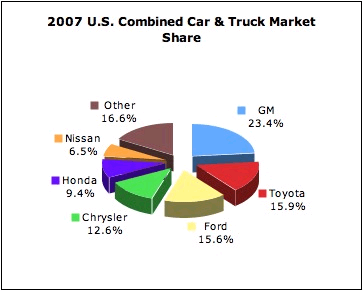| << Chapter < Page | Chapter >> Page > |
Nowhere are the effects of globalization seen more drastically than in the automobile industry, especially for the United States “Big 3” automakers: General Motors, Chrysler, and Ford.
Ford’s history dates back to the Model T created by Henry Ford, with the goal of building a car for every family. Today, Ford is in dire competition with not only their domestic competitors, but also now foreign car manufacturers such as Toyota, Volkswagen and Hyundai.
At the current pace, the automotive market is approaching a 50/50 split between United States and overseas-based control of the US market. As a result, Ford is challenged to constantly reevaluate and revamp its market strategy. This is evident, as Ford decided that it was more cost-effective to buy existing networks than to start from scratch, by bringing Jaguar, Volvo, Mazda, Aston Martin and Land Rover under its control. However, Ford has recently decided to sell its stake in both Jaguar and Land Rover to the Indian automaker, Tata, and may divest other divisions as well.
Today, Ford faces a number of important questions. As the globalization of the auto industry continues, how should Ford market its vehicles? What target markets should Ford appeal to? How can it continue to improve production and quality and adhere to the needs of even more demanding customers? And, how should Ford position itself, as a company, in the face of formidable competition?
While the future of Ford is uncertain, one thing is clear, globalization will continue to affect the way domestic and foreign companies do business.

The growth in cross-border economic activities takes five principal forms: (1) international trade; (2) foreign direct investment; (3) capital market flows; (4) migration (movement of labor); and (5) diffusion of technology (Stiglitz, 2003).
International trade : An increasing share of spending on goods and services is devoted to imports and an increasing share of what countries produce is sold as exports. Between 1990 and 2001, the percentage of exports and imports in total economic output (GDP) rose from 32.3 per cent to 37.9 per cent in industrialized countries, and from 33.8 per cent to 48.9 per cent in low and middle-income countries (World Briefing Paper, 2001). In the 1980s, about 20 per cent of industrialized countries’ exports went to less industrialized countries; today, this share has risen to about 25 per cent, and it appears likely to exceed 33 per cent by 2010 (Qureshi, 1996).
The importance of International trade lies at the root of a country’s economy. In the constant changing business market, countries are now more interdependent than ever on their partners for exporting, importing, thereby keeping the home country’s economy afloat and healthy. For example, China’s economy is heavily dependent on the exportation of goods to the United States, and the United States customer base who will buy these products.

Notification Switch
Would you like to follow the 'Business fundamentals' conversation and receive update notifications?